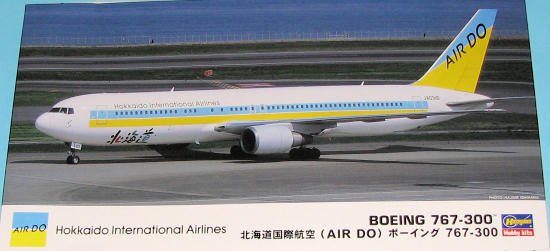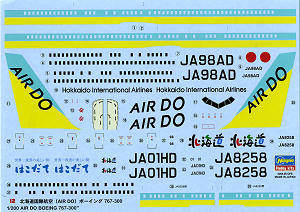
Hasegawa 1/200 Boeing™ 767-300
| KIT: | Hasegawa 1/200 Boeing™ 767-300 |
| KIT #: | 10712 |
| PRICE: | around $30.00 MSRP |
| DECALS: | Hokkaido International Airlines |
| REVIEWER: | Scott Van Aken |
| NOTES: | An oldie but a goodie |

| HISTORY |
The Boeing 767, built in Everett, Wash., alongside the 747, can carry from 200 to 300-plus passengers. The 767 is a wide-body, double-aisle jet, but, like the smaller standard-body 757, is designed for fuel efficiency. Both planes have nearly identical digital cockpits, allowing crews to be easily qualified on both. The 767-200 was first ordered in 1978, and the last was delivered in 1994. Its extended-range model (767-200ER) entered service in 1984. The 767-300 was first ordered in 1986 and was followed by its extended-range model, first delivered in 1988.
The 767 family currently includes three passenger models -- the 767-200ER, 767-300ER and the 767-400ER. The 767-400ER, which first flew in 1999, can carry 304 passengers in a two-class configuration more than 7,000 miles. The 767 Freighter, based on the 767-300ER fuselage, rolled out in May 1995 and was first delivered in October 1995.
| THE KIT |
While it may be a model of a fourth generation airliner, this is a first generation Hasegawa airliner. As a result, nearly all the panel lines are raised. However, this should not be a deterrent to those of us who like to build these kits. Often times we will remove all raised detail to try to emulate a wooden or fiberglas stand model. In fact, even though a clear transparency for the cockpit windows is provided, so is a decal. This holds true for the cabin windows as well, though one will have to fill them to use the decals. I know that many airliner builders like these open windows and clear cockpit windows, so it is nice that Hasegawa provides alternatives.
As you can imagine, there is no interior or cockpit in this scale. The kit is designed to be built wheels down and to that effect, sturdy, and somewhat simplified landing gear struts are provided. To build this in flight, one will have to do some trimming of gear doors and probably need considerable filler to smooth things out. To keep the plane from sitting on its butt, a nice nose weight in the form of a big screw is provided. A nice, but somewhat wobbly stand is provided. To use it one has to open the hole in the fuselage bottom and install and plug that mates to the top of the display.
Probably the worst thing about these kits
is that it is nearly impossible to fill the seam in side
the engine inlets. For those who are really concerned, there are aftermarket
resin engines that can be purchased to take care of this situation.
side
the engine inlets. For those who are really concerned, there are aftermarket
resin engines that can be purchased to take care of this situation.
Despite being a pretty simple kit (I have been know to build one of these in a three day weekend), the instructions provide all the detail one needs. In fact, to properly replicate the two aircraft provided on the sheet, one will need to fill in some windows. One reason there are two sets provided on the large decal sheet. The decals are quite nicely done and as mentioned, allow the builder to do one of two similar planes. As often happens, Hasegawa's 'Air Do' blue on the decals is actually more like turquoise. Flying surfaces are mostly FS 16440 light gull grey (actually, it is probably Boeing Grey, a shade carried by Xtracolor). with 'aircraft grey' inserts and a polished metal leading edge. The main fuselage is white so no worries on any background shades bleeding through the decals. Tail livery is supplied separately in case one wants to paint on the various colors.
| CONCLUSIONS |
I have built several of these Hasegawa 1/200 airliners over the years and have enjoyed every one. They are not difficult builds and provide a colorful addition to your collection without taking up a lot of shelf space. Apparently it is no longer a requirement to plainly place the list price on kit boxes any more, but just under the bar code on the side of the box it is 2200 yen, so that translates to about $24.
| REFERENCES |
July 2008 If you would like your product reviewed fairly and quickly, please
contact
me or see other details in the
Note to
Contributors.